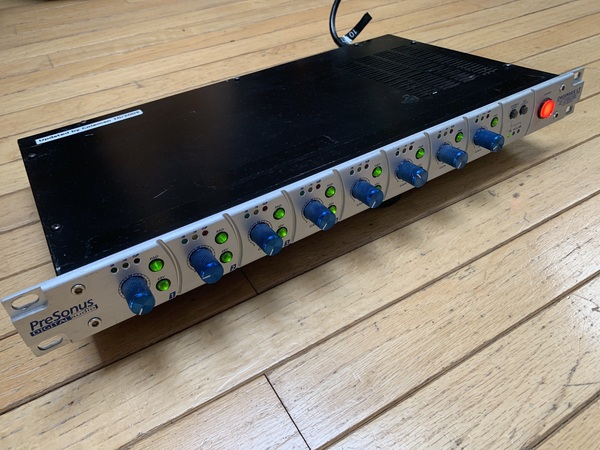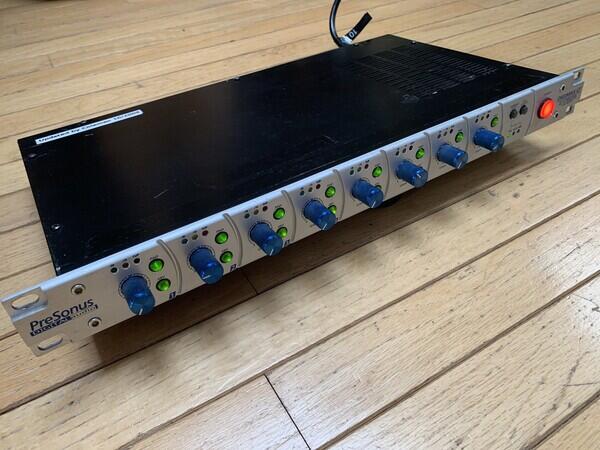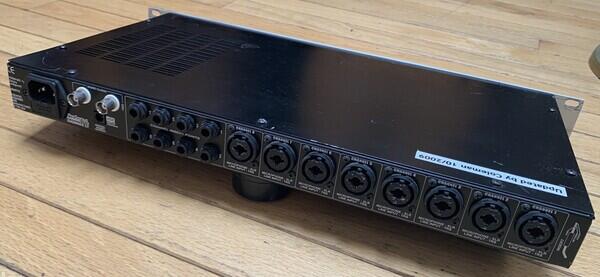PreSonus Digimax LT 8 ch Pre-amps, One with Custom pre-amp improvements and lower noise floor
(Two available) 8 Channel microphone preamp and A to D convertors

8 Ch preamp with custom modifications making it be 12db quieter and having sweeter preamps. Selling for the price of the modification. Feeds any digital interface that has an ADAT 8 channel in.
$350 plus shipping and tax for the fully modified unit.
$250 plus shipping and tax for a partially modified unit.
Call Dan at 617-680-5840 or email at dan@notable.com for more details.
From the Sound On Sound review By Paul White.
Combi jack/XLR connectors and ADAT connectivity help set this smart eight-channel preamp apart from the crowd.
Conceptually, the PreSonus Digimax LT is very straightforward — it is a 1U rack unit providing eight good-quality mic/line preamps, the outputs of which are sent to the outside world as eight 24-bit channels via an ADAT light pipe interface. Word-clock I/O is provided on BNC connectors for synchronization, and phantom power is individually switchable for each channel. There's also a switchable 20dB pad for each channel, but there are no low-cut or phase-reverse switches.
The front panel of the unit is very stylish, made from thick aluminum with rounded edges and milled curved slots to separate the channels. Blue anodized aluminum knobs are used for the gain controls, providing a 40dB adjustment range (maximum gain 54dB), while the mains switch is large, red, and unmissable! Power comes in via an IEC mains socket on the rear panel, and the power supply is a conventional linear design (transformer, diodes, and capacitors) rather than the switched mode.
All the inputs, plus the ADAT light pipe output, are on the rear panel, where Neutrik combi jack/XLR connectors are used to conserve space. The impedance for the mic input is 1.3kΩ and the line inputs are 10kΩ, which is fairly standard. A further eight TRS jacks provide analog insert points after the preamps but prior to A-D conversion. Although there's no 'official' analog output from the unit, it is possible to take an unbalanced feed from the insert sends using an appropriately wired cable. A simple three-LED metering system is used to indicate -30dB, -10dB and Clip (+22dB). This works fine, but setting the Clip light threshold to come on a few decibels below clipping would have made setting up easier. As it is, you need to adjust the gain so the Clip lights just flash on signal peaks, then back them off slightly so that they just don't!
Where the PreSonus Digimax LT is to be used as the clock source, a front-panel button steps through the 32kHz, 44.1kHz and 48kHz options, with a further button to select external clock mode. Because the ADAT light pipe is used to carry the output, higher sample rates are not available.
Technical Specifications
Technically, the mic preamps are very respectable, with 22dB of headroom at the output prior to clipping, a frequency response that's within 0.5dB from 20Hz to 50kHz and a combined unweighted noise/distortion figure of 0.009 percent. The noise floor is 94dB, though the mic amp gain is a shade on the low side at 54dB maximum. This isn't a problem when using a capacitor or dynamic mics in typical close-miking applications, but it may be a concern where dynamic mics are being used to record less loud sources. By contrast, a typical mixing console's mic preamp has a gain of around 60dB, with a further 10dB of gain available if necessary via the channel and output faders.
On a practical note, because combi jack/XLR connectors are used, and because they're positioned on the rear panel, there's no straightforward way to connect up a patch bay to provide a choice of mic or line inputs — whatever is plugged into the back of the unit is what you get. If you're not in the habit of changing things around much, this should be fine, but having one or two 'guest' line inputs on the front panel could have made life easier in some situations. It is possible to use the insert returns to get signals directly into the converters, but as these come after the input amplifier stage you need to have adequate signal level available.
Patching in the Digimax LT is essentially a matter of connecting a light pipe to the input of your system, powering up, and then setting your system to externally sync to the Digimax LT — either that or run everything from a master word-clock source. Everything worked as soon as I had it plugged in, and I was pleasantly surprised by the quality of the mic preamps, which are definitely on the good side of acceptable. There's no obvious coloration, and the sound remains both smooth and clean, which is what you want most of the time. While you can't expect anything too esoteric for this price, the mic amps are a step up from what you get on a typical budget-to-mid-price mixer. There's also plenty of gain for use with capacitor mics, and though the metering isn't particularly fancy you can use the meters in your DAW software to set the mic gain more accurately. Having analog insert points makes it easy to patch in your analog rack compressor or other processors while recording.
Conclusions
The Digimax LT does exactly what it is supposed to do, and it does it to a very respectable standard, though there are cheaper alternatives in the UK that offer perfectly adequate quality and in some cases more features, such as the eight additional balanced line outputs found on the Behringer ADA8000. The Behringer unit also has its inputs on the front where they are more accessible, but arguably less tidy, so there's no single right way of doing things. Similarly, the Digimax LT's combi jack/XLR connectors make good use of space, but if you need to change mic inputs for line inputs, you have to be able to get to the back of the unit.
Where the Digimax LT scores is in providing very nice mic preamps, and it offers a neat and simple way to get eight more good-quality mic or line inputs into any ADAT-equipped soundcard, audio interface, or digital mixer. It also has word-clock in and out, so you can use it as the master clock for your recording system or slave it to an existing master clock. In today's studio, where many of the more complex tasks have been taken over by the computer, having a simple and compact means to add more inputs is extremely welcome.


